When it comes to wedding attire that combines elegance, tradition, and modern style, few options rival the beauty of Japanese kimono and yukata. Their rich cultural heritage and graceful aesthetics make them a truly unique choice for wedding parties,. They offer a blend of sophistication and charm that creates unforgettable memories. Whether you’re planning a traditional Japanese wedding or looking to infuse cultural significance into a modern ceremony, the kimono and yukata offer versatility and timeless appeal.
A Tradition of Beauty and Grace
Kimono, with its elaborate patterns and luxurious fabrics, has been a staple of Japanese weddings for centuries. Traditionally, the bridal “Uchikake” kimono featured three layers in symbolic colors of white, red, and black. The black outer layer adorned with intricate designs was followed by red, symbolizing good luck, and a white underlayer for purity. While this extravagant tradition faded during the Meiji period, the allure of kimono remains. Today, brides and their bridal parties can wear meticulously crafted kimono that reflect this heritage while adapting to modern-day celebrations.
On the other hand, the yukata, a casual and lightweight garment, brings a relaxed elegance to wedding attire. Popular for their comfort and versatility, yukata are often chosen for summer weddings or events with a less formal aesthetic. These garments provide an opportunity to showcase vibrant patterns and playful colors while maintaining an air of sophistication.
Why Kimono and Yukata Are Perfect for Wedding Parties
1. Aesthetic Elegance and Unique Memories
Kimono and yukata instantly elevate the visual appeal of any wedding party. Their unique designs, intricate patterns, and flowing silhouettes create stunning visuals that result in truly memorable wedding photos. When bridesmaids and groomsmen don coordinating yukata or kimono, the visual harmony and cultural significance make for a statement that is unparalleled.
2. Comfort Meets Sophistication
One of the standout qualities of these garments is their ability to combine comfort with beauty. Yukata, crafted from breathable and lightweight fabrics, offers an especially comfortable option for bridal party members who may need to move around throughout the day. Kimono, though more structured, is also designed with wearability in mind for a graceful yet practical choice.
3. Personalization and Cohesion
Kimono and yukata provide opportunities for personalization and coordination. Bridal parties can select matching hues and complementary patterns to achieve a cohesive look that ties together the wedding theme. Bridesmaids can wear cheerful, floral yukata for a spring ceremony, while groomsmen can don timeless, understated tones in their kimono for a minimalist aesthetic.
4. Suitable for Any Wedding Theme
Whether you’re planning a traditional Japanese ceremony or a contemporary celebration, kimono and yukata can adapt seamlessly. They pair beautifully with a Zen garden wedding, an indoor banquet, or even a modern rooftop setting. Their timeless versatility allows them to feel natural in any environment.
Practical Considerations for Wedding Wear
Choosing kimono or yukata for your wedding party does come with a few considerations:
- Dressing Professionals: Wearing kimono, particularly elaborate pieces like the Uchikake, may require the expertise of a professional dresser to ensure the garment is styled correctly.
- Seasonality: Yukata are ideal for warmer seasons, while kimono, with their layered designs, may be more comfortable in cooler weather.
- Accessories: Obi belts, traditional footwear like zori or geta, and hair accessories enhance the kimono and yukata aesthetic further, ensuring a polished and complete look.
Where to Find the Perfect Kimono and Yukata for Your Wedding
To ensure your wedding party looks their absolute best, it’s crucial to source high-quality garments. Look for trusted retailers and brands that prioritize craftsmanship and authentic materials. Many specialty shops also offer customization services to personalize your selection, helping you find pieces that perfectly align with your wedding vision.
Tie Your Special Day Together with Tradition
For brides and grooms who want to bring tradition into a modern love story, kimono and yukata represent an elevated choice for wedding parties. Their timeless appeal, coupled with comfort and versatility, make them the perfect solution for creating unforgettable memories while paying homage to Japanese culture.
Interested in incorporating these stunning garments into your wedding? Explore endless possibilities and find your perfect Uchikake or yukata style. Whether you’re a bride, bridesmaid, or wedding planner, your path to elegant and meaningful attire starts here.














